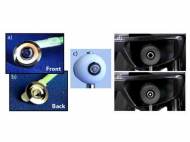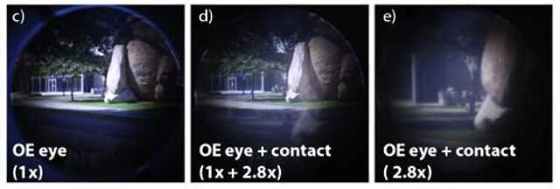The first telescopic contact lens
 Researchers at the Jacobs School of Engineering and the École polytechnique fédérale de Lausanne (EPFL) developed the first telescopic contact lens which can enhance our vision by zooming three times. This 1.17mm thick lens has been created to aid the vision of people with age-related macular degeneration (AMD) which damages the high-resolution center of the retina.
Researchers at the Jacobs School of Engineering and the École polytechnique fédérale de Lausanne (EPFL) developed the first telescopic contact lens which can enhance our vision by zooming three times. This 1.17mm thick lens has been created to aid the vision of people with age-related macular degeneration (AMD) which damages the high-resolution center of the retina.
AMD is the leading cause of blindness among the elderly in the western world and people suffering from this condition cannot improve the blurry vision with ordinary contact lenses. Even though these lenses correct eye’s focus, they cannot restore the central vision lost from a retina damaged by AMD.
Optical instruments that magnify incoming light help AMD patients by spreading light around to undamaged parts of the retina. These visual aids can help patients with a great deal of everyday tasks such as reading, self-care, or even identification of faces. However, these magnifiers are not generally accepted because they either use cumbersome spectacle-mounted telescopes that are inconvenient to carry around, or micro-telescopes that require surgery to implant into the patient’s eye.
The research team created a slim telescopic contact lens that can switch between normal and magnified vision and could offer AMD patients a simple and unobtrusive way to enhance their vision. The new lens system is based on concentric multiple-reflection geometry and it is designed to provide a combination of telescopic and unmagnified vision. It has two very distinctive regions – the center of the lens provides normal vision and the ring-shaped telescope located at the periphery of the regular contact lens. This ring-shaped telescope magnifies the view by 2.8 times.
The user of this contact lens is able to switch between normal and telescopic vision using a polarizing filter in front of the central region of the lens and a modified pair of liquid crystal eyeglasses that are originally made for viewing 3D televisions. These eyeglasses selectively block either the magnifying part of the contact lens or its unmagnified center.
Researchers have tested their design with computer modeling and have created a life-sized model eye that they used to capture images through their contact lens-eyeglasses system. The contact lens is made out of polymethyl methacrylate (PMMA) – a robust material that has been used in early contact lenses. The robustness of the material was suitable for addition of tiny groves that were placed in the lens in order to correct the aberrant color caused by the lens’ shape, which is designed to conform to the human eye.
The magnified image quality through the telescopic contact lens was clear and provided a much larger field of view than other magnification approaches. According to UCSD Photonic Systems Integration Laboratory researchers, the grooves used to correct color had the side effect of degrading image quality and contrast. They made the lens unwearable unless it is surrounded by a smooth, soft “skirt”.
Additionally, PMMA is gas-impermeable and limits wear to short periods of time. To bring their lens to the market, the researchers will need to switch over to rigid gas permeable (RGP) polymers. UCSD researchers also plan to correct aberrant color without the need for grooves to bend the light.
“In the future, it will hopefully be possible to go after the core of the problem with effective treatments or retinal prosthetics. The ideal is really for magnifiers to become unnecessary. Until we get there, however, contact lenses may provide a way to make AMD a little less debilitating”, said Eric Tremblay, scientist at EPFL.
For more information read the article published in the OSA open-access journal Optics Express: “Switchable telescopic contact lens“.










Leave your response!